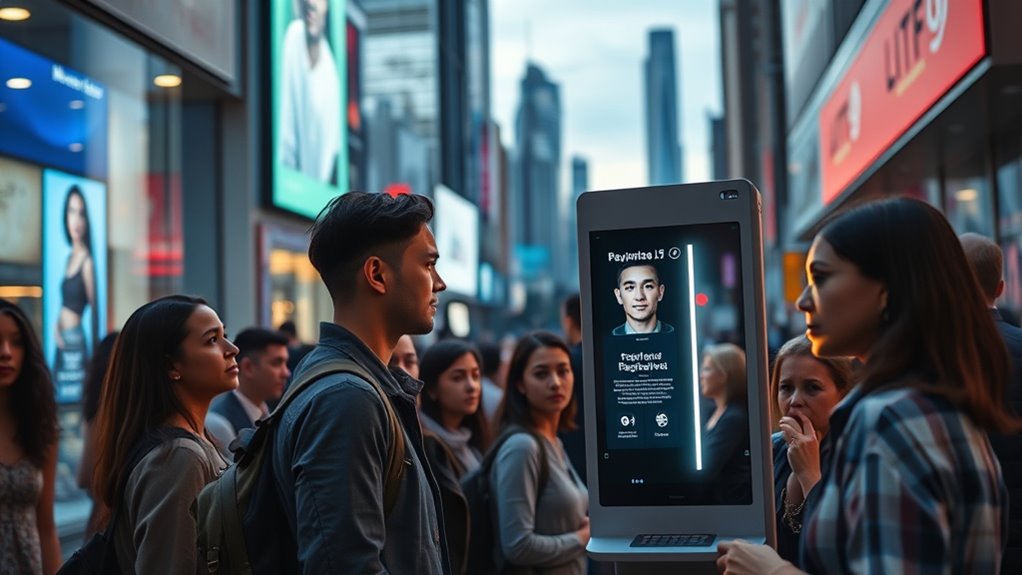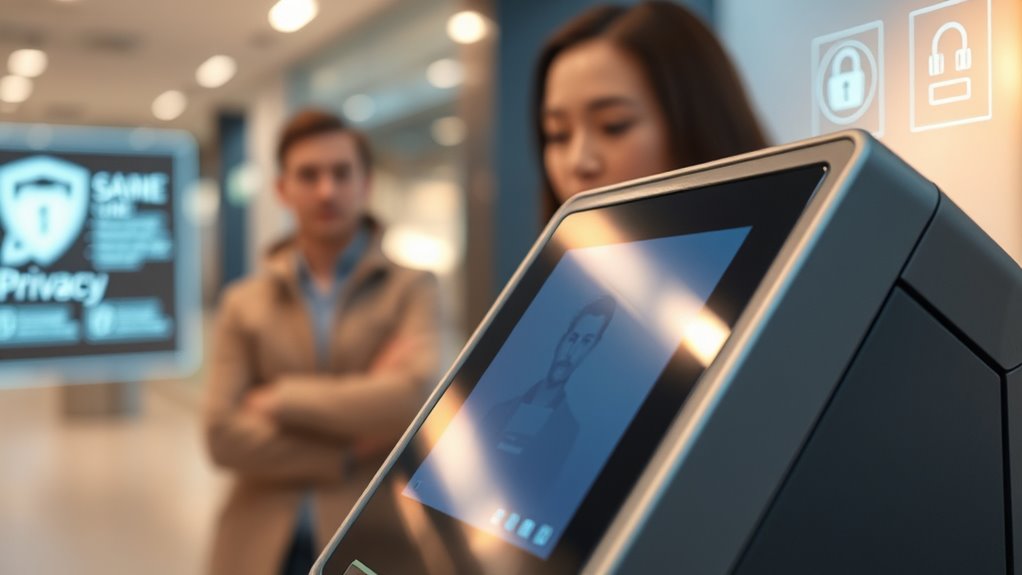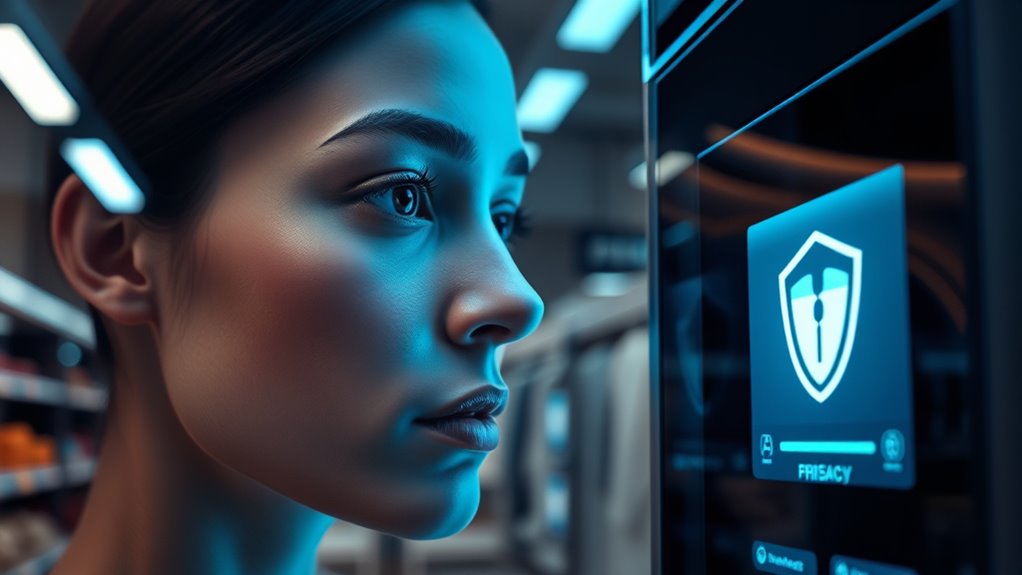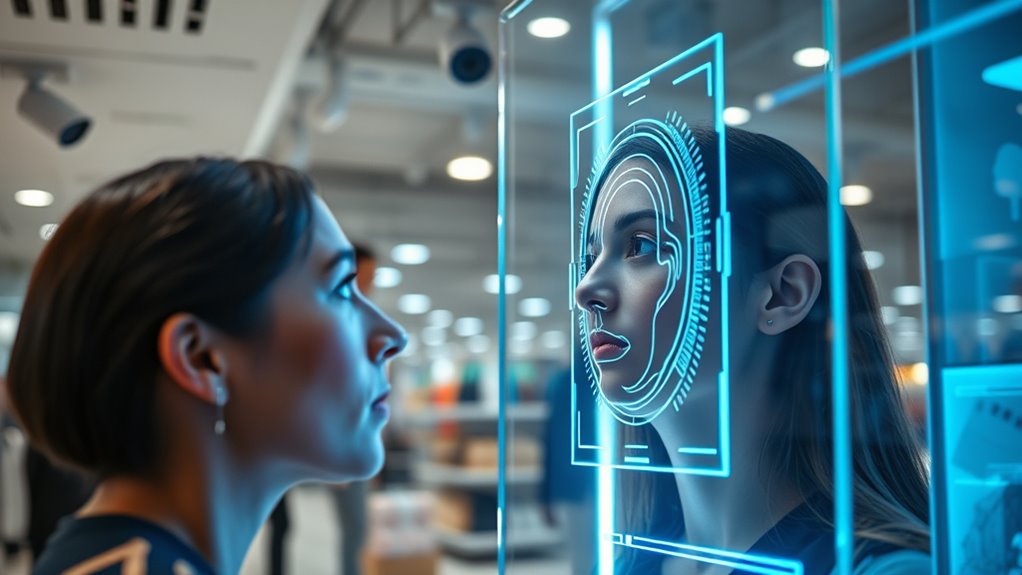Facial-recognition payment technology offers convenience but also raises important privacy concerns. Your facial data, which is biometric and unchangeable if compromised, can be vulnerable to theft, misuse, or endless surveillance without your consent. While laws like GDPR and BIPA aim to protect your rights, gaps remain. Many companies implement encryption and strict data policies to safeguard your information. To understand how to better protect yourself and what industry changes are on the horizon, explore further.
Key Takeaways
- Facial recognition payments require explicit user consent due to privacy laws like GDPR and BIPA.
- Facial data must be encrypted during storage and transmission to prevent breaches and misuse.
- Data retention should be limited, with automated purging to minimize privacy risks.
- Users have rights to access, review, and delete their biometric data under privacy regulations.
- Transparent communication about data use and security practices is essential to build trust.
Understanding Facial-Recognition Technology and Its Use in Payments

Facial-recognition technology has rapidly advanced, making it a viable option for secure and convenient payments. You simply look at a camera, and your face is scanned to verify your identity. The system analyzes unique facial features, like the distance between your eyes or the shape of your jawline, creating a digital map called a biometric template. This template is then compared to stored data to confirm your identity quickly. This process leverages spiritual energy, as some believe that facial features can carry subtle energetic imprints, although the primary basis remains biometric data. Unlike PINs or passwords, facial recognition offers hands-free authentication and reduces fraud risks. It integrates seamlessly with payment systems at retail stores, apps, or ATMs, allowing you to complete transactions in seconds. As technology improves, facial recognition becomes more accurate and reliable, making it increasingly popular for everyday payments.
Privacy Risks Associated With Facial Data Collection and Storage

While facial data collection makes secure payments more convenient, it also raises significant privacy concerns. When your facial data is stored, it becomes vulnerable to breaches or misuse. If a company’s database is hacked, your biometric information could be exposed, leading to identity theft or fraud. Unlike passwords, facial data can’t be changed if compromised, making the risk even greater. Additionally, widespread collection may enable constant tracking of your movements and activities without your knowledge or consent. This persistent surveillance can erode your privacy and autonomy. Organizations may also share or sell your biometric data to third parties, increasing the risk of misuse. Moreover, the process of data encryption can sometimes be insufficient if not properly implemented, further jeopardizing sensitive information. Overall, the collection and storage of facial data pose serious threats to your privacy and control over personal information.
Current Regulations and Legal Protections for Facial-Recognition Payments

You need to understand how existing data privacy laws apply to facial-recognition payments. While some regulations aim to protect your data, gaps and challenges still exist. It’s essential to see where legal protections are strong and where they fall short. Additionally, the use of cookies on related platforms can influence your privacy privacy management.
Existing Data Privacy Laws
Existing data privacy laws play a crucial role in regulating how facial-recognition payment systems collect, store, and use biometric information. These laws set boundaries on data collection and mandate transparency about how your biometric data is handled. You’re protected by regulations requiring companies to obtain your explicit consent before gathering or processing facial data. Laws like the General Data Protection Regulation (GDPR) in Europe enforce strict standards for data security and give you rights to access, correct, or delete your biometric information. In the U.S., laws such as the Illinois Biometric Information Privacy Act (BIPA) provide similar protections. These regulations aim to prevent misuse, ensure accountability, and give you control over your personal biometric data in facial-recognition payment systems. Additionally, biometric data protection frameworks often require ongoing monitoring and regular security assessments to safeguard biometric information effectively.
Regulatory Gaps and Challenges
Are current regulations enough to fully protect your biometric data in facial-recognition payment systems? Not quite. Many existing laws focus on general data privacy but lack specific provisions for biometric information. This creates gaps where companies can collect, store, and share your facial data without clear consent or robust safeguards. Enforcement varies by region, and legislation often lags behind technological advances, leaving potential vulnerabilities. Some regulations don’t define biometric data explicitly or specify strict penalties for misuse. As a result, your privacy could be compromised without proper legal protections. These gaps make it easier for misuse or breaches to occur, highlighting the need for updated, all-encompassing laws that address the unique risks associated with facial-recognition payments. Additionally, the absence of ethical hacking practices in testing these systems leaves vulnerabilities unexamined, increasing the risk of exploitation.
How Companies Are Safeguarding Facial Data and Ensuring User Privacy

Companies protect your facial data through advanced encryption methods that keep your information secure. They also prioritize transparency and seek your consent before collecting data, so you’re aware of how it’s used. Plus, they limit how long they store your data to reduce privacy risks. Implementing privacy policies ensures users are informed about how their data is managed and protected.
Data Encryption Techniques
To protect facial data in facial-recognition payment systems, organizations implement advanced encryption techniques that secure sensitive information from unauthorized access. These methods transform facial images and biometric templates into unreadable formats, ensuring privacy even if data breaches occur. Strong encryption protocols like AES and RSA are commonly used, providing robust defense against hacking attempts. Additionally, data is often encrypted both during transmission and storage, adding multiple layers of security. Ongoing monitoring of AI behavior helps identify vulnerabilities and improve encryption strategies over time. Data is also encrypted both during transmission and storage, adding multiple layers of security.
Consent and Transparency
Building trust in facial-recognition payment systems requires clear communication about how your facial data is collected, used, and protected. Companies should provide straightforward privacy policies that explain what data is gathered, why it’s needed, and how it benefits you. Transparency involves giving you control, such as opting in or out of facial recognition features. Many organizations now seek your explicit consent before capturing your biometric data, ensuring you’re aware of its purpose. They also regularly update you about any changes to their privacy practices. By openly sharing this information, companies demonstrate respect for your privacy rights and build confidence in their systems. Additionally, understanding Vetted – Grobal World principles can help consumers make more informed decisions about their biometric data. Clear, honest communication is essential for establishing a trustworthy environment where you feel safe using facial-recognition payments.
Limited Data Retention
By limiting how long facial data is stored, organizations actively protect your privacy and reduce the risk of misuse. Shortening data retention periods ensures your biometric information isn’t kept longer than necessary, lowering the chance of breaches or unauthorized access. Companies adopting this approach often implement policies such as:
- Regularly deleting outdated facial recognition data
- Setting strict timeframes for data storage
- Using automated systems to purge data after a set period
- Emphasizing the importance of anime movies and their storytelling to foster understanding and cultural appreciation
These measures demonstrate a commitment to privacy, ensuring your facial information isn’t lingering in databases indefinitely. The shorter the retention period, the less vulnerable your data becomes. This practice aligns with privacy principles and helps build trust, showing that organizations prioritize safeguarding your biometric information and respect your right to control your data.
Consumer Rights and Best Practices for Protecting Personal Information

As facial-recognition payment systems become more common, it’s essential for you to understand your rights and how to protect your personal information. First, always review privacy policies to know how your biometric data is collected, stored, and used. You have the right to request access to your data and to ask companies to delete it if you no longer want them to hold it. Use strong, unique passwords for your accounts and enable multi-factor authentication where possible. Be cautious about sharing biometric data and only use trusted, reputable services. Stay informed about updates to privacy laws and company policies. Regularly assessing and revisiting your data management practices can help in maintaining control over your personal information. By actively managing your privacy settings and staying aware, you can better safeguard your personal information in facial-recognition payment systems.
Future Trends and Considerations in Facial-Recognition Payment Privacy

Emerging technologies and evolving regulations will shape the future of facial-recognition payment privacy, making it increasingly important for you to stay informed. Advancements like AI-driven encryption and decentralized data storage could enhance your privacy protections. Meanwhile, stricter laws and standards may require companies to adopt transparent practices and obtain clearer consent. Looking ahead, you might see more biometric authentication options integrated with privacy controls, giving you greater control over your data. To navigate these changes, consider staying updated on legal developments and best practices.
Emerging tech and regulations will enhance privacy, transparency, and user control in facial-recognition payments.
- The rise of privacy-focused biometric solutions that minimize data collection
- Increased transparency requirements from companies handling biometric data
- Enhanced user control over consent and data sharing in payment processes
Frequently Asked Questions
How Can Consumers Opt Out of Facial-Recognition Payment Systems?
You can usually opt out of facial-recognition payment systems by checking the privacy settings on the app or device you’re using. Look for options related to biometric data or facial recognition, and disable or revoke permission. If no option exists, contact customer support or visit the company’s privacy policy page for instructions. Remember, staying informed about your privacy rights helps you control your personal information effectively.
What Are the Potential Legal Consequences for Data Breaches?
If a data breach occurs, you could face serious legal consequences, including hefty fines and lawsuits. Companies might be held liable for failing to protect your personal information properly, especially if they neglect industry standards or violate data protection laws. This can damage their reputation and lead to regulatory investigations. As a consumer, you might also seek legal action to recover damages, emphasizing the importance of robust security measures.
Are There Specific Industries More Prone to Facial-Recognition Payment Risks?
Is the landscape of facial-recognition payment risks a game of favorites? You’ll find industries like retail, banking, and healthcare more vulnerable because they handle sensitive data and high transaction volumes. These sectors must navigate privacy laws carefully to avoid breaches. Your best move is to implement robust security measures and clear consent protocols, turning potential pitfalls into opportunities for trust and transparency. Stay proactive—your safeguards define your reputation.
How Does Biometric Data Encryption Work in Payment Systems?
Biometric data encryption in payment systems protects your sensitive information by converting it into unreadable code using advanced algorithms. When you make a payment, your biometric data, like a facial scan, is encrypted immediately, ensuring only authorized systems can decrypt and verify it. This process keeps your data secure during transmission and storage, reducing the risk of hacking or unauthorized access, and maintaining your privacy during transactions.
What Role Do International Laws Play in Cross-Border Facial Recognition Use?
International laws shape how you can use facial recognition across borders by setting rules for data privacy, security, and consent. They guarantee that your biometric data is protected and that you’re informed about how your information is shared or stored internationally. These laws also require companies to follow strict standards, reducing misuse and safeguarding your privacy. By adhering to these regulations, you help maintain trust and safety in cross-border facial recognition applications.
Conclusion
Think of facial-recognition payments as a delicate garden—you hold the key to its beauty and safety. By understanding the risks, respecting regulations, and practicing smart privacy habits, you’re like a vigilant gardener tending to your personal data. With careful care and awareness, you can enjoy the bloom of convenience without letting unwanted weeds of privacy invasion take root. Stay informed and proactive—your digital garden thrives best when you’re its attentive caretaker.









